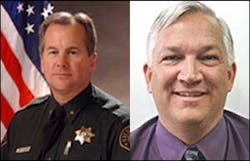A chaotic scene is not the time for law enforcement and fire commanders to have their first face-to-face encounter. But, that's just what happened at Columbine High School eight years ago today.
The rampage this week at Virginia Tech that stunned the world has also brought a flood of memories for two Colorado men, intricately involved at the deadly high school shooting.
Two students shot and killed 12 of their classmates and one teacher before taking their own lives inside the suburban high school on April 20, 1999.
There was no initial commander or command structure. Several agencies answered the call to assist, and sent officers. But, they couldn't talk to each other, said Dave Walcher, division chief of Jefferson County Sheriff's Office.
"Word traveled fast. In addition to police, we had first responders and parents converging. It was a large campus just like Virginia Tech. We had no idea where the other officers were or what they were doing. The radios were on different channels," Walcher said in a telephone interview Friday.
He said initial reports indicated there may have been as many as five or six shooters. SWAT team members from various forces moved in as a unit in an attempt to determine the situation.
But, there was still no coordination. "I realized we needed to get a grip on things. We had extraordinary response from police, fire departments and ambulances."
As in the VT incident, cell phone service was quickly overwhelmed and useless. "I got there within 16 minutes, and could not use my phone," Walcher said.
Walcher was credited with assuming command, which former Littleton Fire Chief Bill Pessemier said was not an easy task. "It was like herding cats. He did a fabulous job."
The deputy, a lieutenant at the time, said he'd never met the chief before. "We shook hands, and just started talking about the task at hand and what we needed to do ... We had to contain the situation."
Pessemier, who has since retired from the fire department, said he urges agencies to not only write an emergency response plan, but practice it. It's essential that commanders are familiar with one another before an incident occurs.
Once command was established at Columbine, Pessemier said things went smoothly. "We were on the same page, and were working together. That's what you need, a regional approach.
All 26 people evacuated from the school survived.
Walcher said it's fortunate that the shooters did not complete their original mission. "They were planning to leave and go out into the community and continue the rage."
Pessemier said a knot tightened in his stomach all over again when he watched the VT events unfolding on television. "(It was) so tragic, so sad. All the lost opportunities with those young lives ... It's also been inspiring to see the spirit displayed around Virginia Tech."
Both men said they are not surprised by the second-guessing and criticism of VT authorities.
"You make the best decision based on the knowledge you have at the time," Walcher said. "You are always going to have people second guessing."
Pessemier said much of the Monday morning quarterbacking is coming from people not familiar with law enforcement. He said decisions aren't made on a whim.
Fire, rescue and police involved were offered psychological counseling to help deal with their grief. Both group and individual sessions were available. "People react differently to stress," Pessemier said.
After Columbine, personnel developed a program in an attempt to prevent another tragedy. "We found many students were lacking in social skills," the chief said, adding that they didn't know how to communicate. "And, there's still a tremendous trust of firefighters."
Their first class -- in an alternative high school -- had a greater impact than they imagined. "We received many letters. Some were from parents, some from students and staff."
Police officers also went into the classrooms to develop relationships with students. "We tell them it's OK to report something suspicious or someone who is acting strangely," Walcher said.
In addition, regional SWAT teams were formed, and they practice specific techniques developed after the incident. EMTs and paramedics were added to the squads as well.
Pessemier said radio communications have been enhanced that enables agencies to talk to one another should a similar incident arise.
All those involved in the incident -- including the school district -- are familiar with what's expected of them. "We're better prepared because we all have a better relationship," Walcher said.
"What happened in VT is just absolutely tragic," he said. "So very said."






